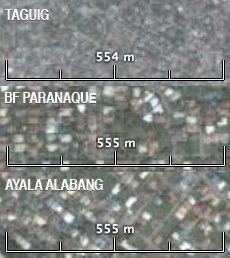going mental 4: walled out and edgeless
  | Going back to our conceptual analysis of Metro Manila. Take a look at the first image. Where does metro manila physically end? I know there are the political boundaries of the NCR cities and municipalities -but as far as actual scope of urbanization, where does it end? When do you know you've left the city and have entered the countryside? Cavite, Laguna and Batangas are becoming as intensely urban as southern Metro Manila and the metropolis has become edgeless. (Calabarzon actually has a larger population than the NCR. The Southern Tagalog urbanized population is also growing faster than the NCR.) This blurred edge was also hastened by the loophole in Agrarian Reform Law that allowed landowners to keep their holdings if the land was no longer in agricultural use. Most of Cavite's once productive farmlands are now zoned for other uses (commercial, industrial or residential). Our metropolis not only sprawls north, south and east but it also is largely homogenous - residential subdivision after residential subdivision -variagated only only in housing size and income. It is income that largely differentiates and defines our residential districts. The metropolis is quartered by gated communities that often frustrate effective transportation and traffic patterns. The second image shows the differing grain in house size that also stands in for the economic strata of the residents -from Ayala Alabang (A), to BF Paranaque (A and upper B) to Taguig (C & D). What makes these gated villages different from the rest of the metropolis is that value of land inside the gates tends to appreciate faster than the rest of the metropolis. (And yet the size of the middle and upper class does not seem to be expanding so it makes you wonder if the rich are only selling to themselves.) In cities that grew up before the automobile (i.e. -their transport options included walking, animal drawn carriages or trains), you can take the land values map and it will almost mirror the relative heights of buildings. More expensive land tends to encourage taller buildings. Land that is also more connected by infrastructure (i.e. -the closer you are to a mass transit station) also tends to command a higher price. Two forces drive the alternative effect in our metropolis: In a polycentric city like ours (like LA and Atlanta), the land values correspond to preferred elite communities -and reflect the value in shared amenities that the original developer put in (i.e. -roads, sewer, water, trees, parks etc. -as well as security). The other driving force is adjacency to high value commercial property (think the gated communities of the Makati CBD or Greenhills and the Valle Verdes) -or a private amenity such as a golf course or a premier university (think Wakwak, Ayala Heights or Ayala Alabang.) Our gated communities also echo the historic intra of the Intramuros. To the extramuros (the arraballes of old) belong the great unwashed -the service people and the crop growers who tend the fields and businesses owned by the elite living inside the gates. (See Carlos' outstanding essay on the demise of the mestizo class.) It also reflects the inverse level of investment (by the national and local governments) in public facilities outside the gated communities. While the edgeless sprawling urbanity is the built on the relative weakness of the agrarian economy in lands adjacent to the metropolis. The good news is gated communities are not unique to Metro Manila. Other cities suffer the same kind of economic segregation and are searching for politically palatable (read: incentives) options to get the gates open. We will learn from their innovations. |

No comments:
Post a Comment